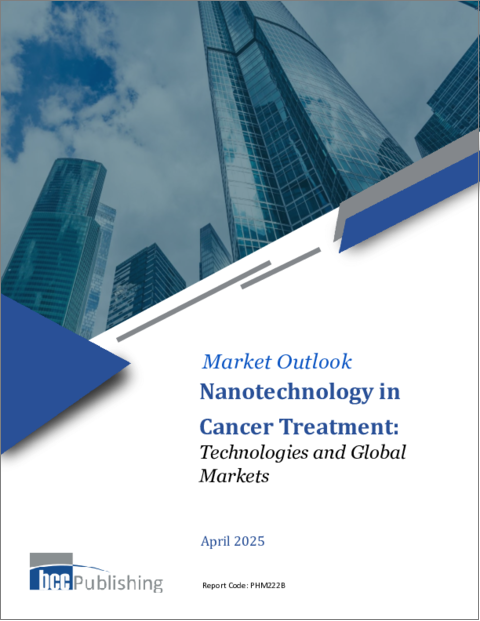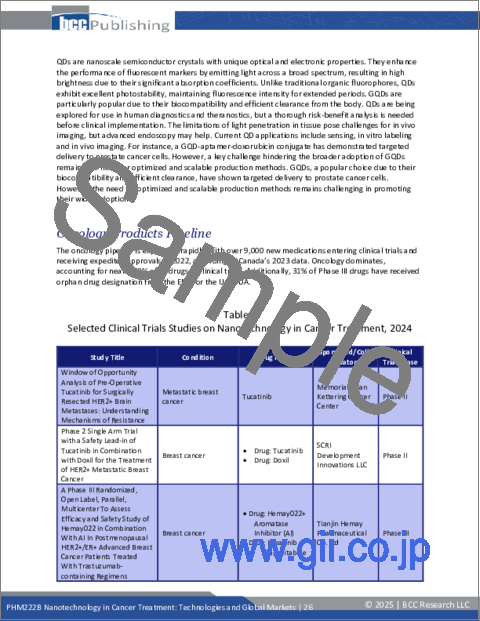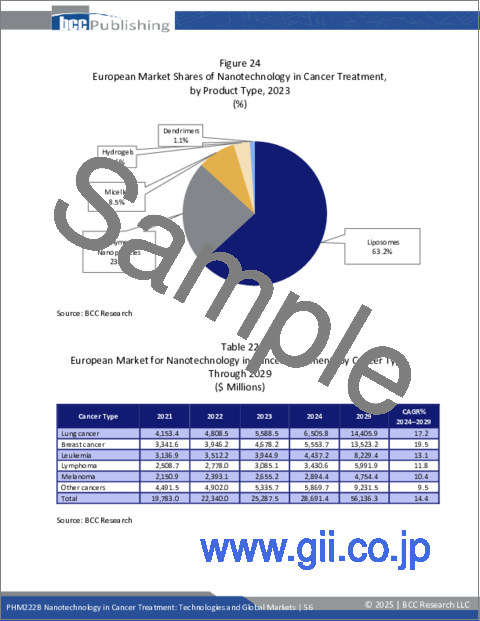|
|
市場調査レポート
商品コード
1708114
癌治療におけるナノテクノロジー:各種技術と世界市場Nanotechnology in Cancer Treatment: Technologies and Global Markets |
||||||
|
|||||||
| 癌治療におけるナノテクノロジー:各種技術と世界市場 |
|
出版日: 2025年04月15日
発行: BCC Research
ページ情報: 英文 107 Pages
納期: 即納可能
|
全表示
- 概要
- 図表
- 目次
当レポートでは、癌治療におけるナノテクノロジーの市場を調査し、市場概要、市場影響因子および市場機会の分析、法規制環境、新興技術および技術開発の動向、市場規模の推移・予測、各種区分・地域別の詳細分析、競合情勢、主要企業のプロファイルなどをまとめています。
目次
第1章 エグゼクティブサマリー
- 市場見通し
- 調査範囲
- 市場サマリー
第2章 市場概要
- 概要
- 特許分析
- ポーターのファイブフォース分析
- 将来の展望
第3章 市場力学
- 市場力学
- 市場促進要因
- 世界的な癌の罹患率の増加
- 政府資金と医薬品研究開発費の増加
- 癌治療におけるナノ粒子:利点
- ナノ材料による癌細胞の精密標的化
- 市場抑制要因
- ナノ粒子の臨床使用における障害
- 腫瘍専門家の不足
- 市場機会
- 薬剤耐性克服におけるナノ粒子のメカニズム
- 癌プロテオミクス
第4章 規制状況
- 概要
- 米国
- 欧州
- 日本
第5章 新興技術と新開発
- 新たな動向と技術
- AI
- 量子ドット
- 腫瘍製品パイプライン
第6章 市場セグメント分析
- セグメンテーションの内訳
- 市場分析:製品タイプ別
- 世界の市場規模・予測
- リポソーム
- ポリマーナノ粒子
- ミセル
- ハイドロゲル
- デンドリマー
- 市場分析:癌タイプ別
- 世界の市場規模・予測
- 肺癌
- 乳癌
- 白血病
- リンパ腫
- 黒色腫
- その他
- 地理的内訳
- 市場分析:地域別
- 世界の市場規模・予測
- 北米
- 欧州
- アジア太平洋
- 中東・アフリカ
- 南米
第7章 競合情報
- 概要
- 競合情勢
第8章 付録
- 調査手法
- 略語
- 出典
- 企業プロファイル
- ASTRAZENECA
- BAXTER
- BOSTON SCIENTIFIC CORP.
- BRISTOL-MYERS SQUIBB CO.
- F. HOFFMANN-LA ROCHE LTD.
- JAZZ PHARMACEUTICALS INC.
- LES LABORATOIRES SERVIER
- NOVARTIS AG
- PFIZER INC.
- TEVA PHARMACEUTICAL INDUSTRIES LTD.
- その他の新興企業
List of Tables
- Summary Table : Global Market for Nanotechnology in Cancer Treatment, by Product Type, Through 2029
- Table 1 : Select Patent Grants on Nanotechnology in Cancer Treatment, 2024 and 2025
- Table 2 : Porter's Five Forces Analysis: Nanotechnology in Cancer Treatment Market
- Table 3 : Selected Clinical Trials Studies on Nanotechnology in Cancer Treatment, 2024
- Table 4 : Global Market for Nanotechnology in Cancer Treatment, by Product Type, Through 2029
- Table 5 : Global Market for Nanotechnology-based Liposomes in Cancer Treatment, by Region, Through 2029
- Table 6 : Global Market for Nanotechnology-based Polymeric Nanoparticles in Cancer Treatment, by Region, Through 2029
- Table 7 : Global Market for Nanotechnology-based Micelles in Cancer Treatment, by Region, Through 2029
- Table 8 : Global Market for Nanotechnology-based Hydrogels in Cancer Treatment, by Region, Through 2029
- Table 9 : Global Market for Nanotechnology-based Dendrimers in Cancer Treatment, by Region, Through 2029
- Table 10 : Global Market for Nanotechnology in Cancer Treatment, by Cancer Type, Through 2029
- Table 11 : Global Market for Nanotechnology in Lung Cancer Treatment, by Region, Through 2029
- Table 12 : Global Market for Nanotechnology in Breast Cancer Treatment, by Region, Through 2029
- Table 13 : Global Market for Nanotechnology in Leukemia Cancer Treatment, by Region, Through 2029
- Table 14 : Global Market for Nanotechnology in Lymphoma, by Region, Through 2029
- Table 15 : Global Market for Nanotechnology in Melanoma Treatment, by Region, Through 2029
- Table 16 : Global Market for Nanotechnology in Other Cancers, by Region, Through 2029
- Table 17 : Global Market for Nanotechnology in Cancer Treatment, by Region, Through 2029
- Table 18 : North American Market for Nanotechnology in Cancer Treatment, by Product Type, Through 2029
- Table 19 : North American Market for Nanotechnology in Cancer Treatment, by Cancer Type, Through 2029
- Table 20 : North American Market for Nanotechnology in Cancer Treatment, by Country, Through 2029
- Table 21 : European Market for Nanotechnology in Cancer Treatment, by Product Type, Through 2029
- Table 22 : European Market for Nanotechnology in Cancer Treatment, by Cancer Type, Through 2029
- Table 23 : European Market for Nanotechnology in Cancer Treatment, by Country, Through 2029
- Table 24 : Asia-Pacific Market for Nanotechnology in Cancer Treatment, by Product Type, Through 2029
- Table 25 : Asia-Pacific Market for Nanotechnology in Cancer Treatment, by Cancer Type, Through 2029
- Table 26 : Asia-Pacific Market for Nanotechnology in Cancer Treatment, by Country, Through 2029
- Table 27 : Middle East and African Market for Nanotechnology in Cancer Treatment, by Product Type, Through 2029
- Table 28 : Middle East and African Market for Nanotechnology in Cancer Treatment, by Cancer Type, Through 2029
- Table 29 : South American Market for Nanotechnology in Cancer Treatment, by Product Type, Through 2029
- Table 30 : South American Market for Nanotechnology in Cancer Treatment, by Cancer Type, Through 2029
- Table 31 : Major Market Players in Nanotechnology in Cancer Treatment, 2023
- Table 32 : Abbreviations Used in this Report
- Table 33 : Information Sources in this Report
- Table 34 : AstraZeneca: Company Snapshot
- Table 35 : AstraZeneca: Financial Performance, FY 2022 and 2023
- Table 36 : AstraZeneca: Product Portfolio
- Table 37 : AstraZeneca: News/Key Developments, 2023 and 2024
- Table 38 : Baxter: Company Snapshot
- Table 39 : Baxter: Financial Performance, FY 2022 and 2023
- Table 40 : Baxter: Product Portfolio
- Table 41 : Baxter: News/Key Developments, 2021
- Table 42 : Boston Scientific Corp.: Company Snapshot
- Table 43 : Boston Scientific Corp.: Financial Performance, FY 2022 and 2023
- Table 44 : Boston Scientific Corp.: Product Portfolio
- Table 45 : Boston Scientific Corp.: News/Key Developments, 2021
- Table 46 : Bristol-Myers Squibb Co.: Company Snapshot
- Table 47 : Bristol-Myers Squibb Co.: Financial Performance, FY 2022 and 2023
- Table 48 : Bristol-Myers Squibb Co.: Product Portfolio
- Table 49 : F. Hoffmann-La Roche Ltd.: Company Snapshot
- Table 50 : F. Hoffmann-La Roche Ltd.: Financial Performance, FY 2022 and 2023
- Table 51 : F. Hoffmann-La Roche Ltd.: Product Portfolio
- Table 52 : Jazz Pharmaceuticals Inc.: Company Snapshot
- Table 53 : Jazz Pharmaceuticals Inc.: Financial Performance, FY 2022 and 2023
- Table 54 : Jazz Pharmaceuticals Inc.: Product Portfolio
- Table 55 : Les Laboratoires Servier: Company Snapshot
- Table 56 : Les Laboratoires Servier: Financial Performance, FY 2022 and 2023
- Table 57 : Les Laboratoires Servier: Product Portfolio
- Table 58 : Les Laboratoires Servier: News/Key Developments, 2023 and 2024
- Table 59 : Novartis AG: Company Snapshot
- Table 60 : Novartis AG: Financial Performance, FY 2022 and 2023
- Table 61 : Novartis AG: Product Portfolio
- Table 62 : Pfizer Inc.: Company Snapshot
- Table 63 : Pfizer Inc.: Financial Performance, FY 2022 and 2023
- Table 64 : Pfizer Inc.: Product Portfolio
- Table 65 : Pfizer Inc.: News/Key Developments, 2023
- Table 66 : Teva Pharmaceutical Industries Ltd.: Company Snapshot
- Table 67 : Teva Pharmaceutical Industries Ltd.: Financial Performance, FY 2022 and 2023
- Table 68 : Teva Pharmaceutical Industries Ltd.: Product Portfolio
- Table 69 : Few Emerging Players in Nanotechnology in Cancer Treatment Market
List of Figures
- Summary Figure : Global Market Shares of Nanotechnology in Cancer Treatment, by Product Type, 2023
- Figure 1 : Market Dynamics of Nanotechnology in Cancer Treatment
- Figure 2 : Breakdown of Most Frequent Cancers in Women, by Type, 2022
- Figure 3 : Breakdown of Most Frequent Cancers in Men, by Type, 2022
- Figure 4 : Estimated Cancer Incidence and Mortality Cases Globally, by Cancer Type, 2024
- Figure 5 : Trends in NCI Funding for Cancer Research, by Year, 2012-2019
- Figure 6 : Global Pharmaceutical R&D Spending, 2020-2026
- Figure 7 : Global Market Shares of Nanotechnology in Cancer Treatment, by Product Type, 2023
- Figure 8 : Global Market Shares of Nanotechnology-based Liposomes in Cancer Treatment, by Region, 2023
- Figure 9 : Global Market Shares of Nanotechnology-based Polymeric Nanoparticles in Cancer Treatment, by Region, 2023
- Figure 10 : Global Market Shares of Nanotechnology-based Micelles in Cancer Treatment, by Region, 2023
- Figure 11 : Global Market Shares of Nanotechnology-based Hydrogels in Cancer Treatment, by Region, 2023
- Figure 12 : Global Market Shares of Nanotechnology-based Dendrimers in Cancer Treatment, by Region, 2023
- Figure 13 : Global Market Shares of Nanotechnology in Cancer Treatment, by Cancer Type, 2023
- Figure 14 : Global Market Shares of Nanotechnology in Lung Cancer Treatment, by Region, 2023
- Figure 15 : Global Market Shares of Nanotechnology in Breast Cancer Treatment, by Region, 2023
- Figure 16 : Global Market Shares of Nanotechnology in Leukemia Cancer Treatment, by Region, 2023
- Figure 17 : Global Market Shares of Nanotechnology in Lymphoma, by Region, 2023
- Figure 18 : Global Market Shares of Nanotechnology in Melanoma Treatment, by Region, 2023
- Figure 19 : Global Market Shares of Nanotechnology in Other Cancers, by Region, 2023
- Figure 20 : Global Market Shares of Nanotechnology in Cancer Treatment, by Region, 2023
- Figure 21 : North American Market Shares of Nanotechnology in Cancer Treatment, by Product Type, 2023
- Figure 22 : North American Market Shares of Nanotechnology in Cancer Treatment, by Cancer Type, 2023
- Figure 23 : North American Market Shares of Nanotechnology in Cancer Treatment, by Country, 2023
- Figure 24 : European Market Shares of Nanotechnology in Cancer Treatment, by Product Type, 2023
- Figure 25 : European Market Shares of Nanotechnology in Cancer Treatment, by Cancer Type, 2023
- Figure 26 : European Market Shares of Nanotechnology in Cancer Treatment, by Country, 2023
- Figure 27 : Asia-Pacific Market Shares of Nanotechnology in Cancer Treatment, by Product Type, 2023
- Figure 28 : Asia-Pacific Market Shares of Nanotechnology in Cancer Treatment, by Cancer Type, 2023
- Figure 29 : Asia-Pacific Market Shares of Nanotechnology in Cancer Treatment, by Country, 2023
- Figure 30 : Middle East and African Market Shares of Nanotechnology in Cancer Treatment, by Product Type, 2023
- Figure 31 : Middle East and African Market Shares of Nanotechnology in Cancer Treatment, by Cancer Type, 2023
- Figure 32 : South American Market Shares of Nanotechnology in Cancer Treatment, by Product Type, 2023
- Figure 33 : South American Market Shares of Nanotechnology in Cancer Treatment, by Cancer Type, 2023
- Figure 34 : AstraZeneca: Revenue Share, by Business Unit, FY 2023
- Figure 35 : AstraZeneca: Revenue Share, by Country/Region, FY 2023
- Figure 36 : Baxter: Revenue Share, by Business Unit, FY 2023
- Figure 37 : Baxter: Revenue Share, by Country/Region, FY 2023
- Figure 38 : Boston Scientific Corp.: Revenue Shares, by Business Unit, FY 2023
- Figure 39 : Boston Scientific Corp.: Revenue Shares, by Country/Region, FY 2023
- Figure 40 : Bristol-Myers Squibb Co.: Revenue Share, by Business Unit, FY 2023
- Figure 41 : Bristol-Myers Squibb Co.: Revenue Share, by Country/Region, FY 2023
- Figure 42 : F. Hoffmann-La Roche Ltd.: Revenue Share, by Business Unit, FY 2023
- Figure 43 : F. Hoffmann-La Roche Ltd.: Revenue Share, by Country/Region, FY 2023
- Figure 44 : Jazz Pharmaceuticals Inc.: Revenue Share, by Business Unit, FY 2023
- Figure 45 : Jazz Pharmaceuticals Inc.: Revenue Share, by Country/Region, FY 2023
- Figure 46 : Les Laboratoires Servier: Revenue Share, by Business Unit, FY 2023
- Figure 47 : Les Laboratoires Servier: Revenue Share, by Region, FY 2023
- Figure 48 : Novartis AG: Revenue Share, by Business Unit, FY 2023
- Figure 49 : Novartis AG: Revenue Share, by Country/Region, FY 2023
- Figure 50 : Pfizer Inc.: Revenue Share, by Business Unit, FY 2023
- Figure 51 : Pfizer Inc.: Revenue Share, by Country/Region, FY 2023
- Figure 52 : Teva Pharmaceutical Industries Ltd.: Market Share, by Business Unit, FY 2023
- Figure 53 : Teva Pharmaceutical Industries Ltd.: Market Share, by Region, FY 2023
The report provides an analysis of the global market for nanotechnology in cancer treatment. Using 2023 as the base year, the report provides estimated market data for 2024 through 2029. The market in this report is segmented into product type, cancer type, and region. The report concludes with profiles of the major players in the market.
Report Scope
This report provides detailed information about nanotechnology in the cancer treatment market. The report analyzes the market trends for nanotechnology in cancer treatment with data from 2023, estimates from 2024, projections of compound annual growth rates through 2029 (forecast period 2024-2029), and regional markets. This report highlights nanotechnology in cancer treatment's current and future market potential and analyzes the competitive environment. The report covers regulatory scenarios, drivers, restraints and opportunities. The report also covers market estimates for 2029 and market shares for key players.
The market scope in this report is segmented into product type and cancer types. Based on product type, the market is segmented into liposomes, polymeric nanoparticles, micelles, hydrogels, and dendrimers. The market is segmented by cancer type into lungs, breast, leukemia, lymphoma, melanoma and other cancers.
The market has been segmented into the following regions: North America, Europe, Asia-Pacific, the Middle East and Africa, and South America. The regional segment includes a detailed analysis of major countries such as the U.S., Canada, Mexico, Germany, the U.K., Italy, Spain, France, Japan, China, South Korea, Australia and India. For market projections, data will be provided for 2023 as the base year, with forecasts for 2024 through 2029.
The report's goals include:
- Analyzing product and cancer type.
- Analyzing global market size and segments.
- Reviewing market constraints and drivers.
- Providing detailed market forecasts for 2029.
- Assessing market shares, competitiveness and industry structure.
- Identifying potential long-term impacts on nanotechnology in the cancer treatment market.
Report Includes
- Analyses of the trends in global markets for nanotechnology in cancer treatment, with revenue data for 2022 to 2023, estimates for 2024, forecasts for 2025, and projected CAGRs through 2029
- Estimates of the size and revenue prospects for the global market, along with a market share analysis by product type, application and region
- Facts and figures pertaining to the global market dynamics, technological advances, regulations and standards, and the impact of macroeconomic factors
- Insights derived from the Porter's Five Forces model, as well as global supply chain and PESTLE analyses
- Information pertaining to evolving trends and patterns, recent technological breakthroughs, and the types of nanostructured materials, nanodevices, and nanotools used for research, diagnosis and therapy of the types of cancer
- Statistics regarding the incidence and prevalence of cancer cases, as well as global mortality figures
- Analysis of relevant patents and patent grants
- Overview of sustainability trends and ESG developments, with emphasis on consumer attitudes, and the ESG scores and practices of leading companies
- Analysis of the industry structure, including companies' market shares and rankings, strategic alliances, M&A activity and a venture funding outlook
- Profiles of leading companies
Table of Contents
Chapter 1 Executive Summary
- Market Outlook
- Scope of Report
- Market Summary
Chapter 2 Market Overview
- Overview
- Patent Analysis
- Analysis of Porter's Five Forces
- Bargaining Power of Buyers
- Bargaining Power of Suppliers
- Potential for New Entrants
- Threat of Substitutes
- Competitiveness in the Industry
- Future Perspective
Chapter 3 Market Dynamics
- Market Dynamics
- Market Drivers
- Increasing Prevalence of Cancer Cases Globally
- Rise in Government Funding and Pharmaceutical R&D Spending
- Nanoparticles in Cancer Treatment: Advantages
- Precision Targeting of Cancer Cells with Nanomaterials
- Market Restraints
- Roadblocks to Clinical Nanoparticle Use
- Lack of Oncology Professionals
- Market Opportunities
- Mechanism of Nanoparticles in Overcoming Drug Resistance
- Cancer Proteomics
Chapter 4 Regulatory Landscape
- Overview
- U.S.
- Europe
- Japan
Chapter 5 Emerging Technologies and New Developments
- Emerging Trends and Technologies
- Artificial Intelligence
- Quantum Dots
- Oncology Products Pipeline
Chapter 6 Market Segment Analysis
- Segmentation Breakdown
- Market Analysis by Product Type
- Global Market Size and Forecast
- Liposomes
- Polymeric Nanoparticles
- Micelles
- Hydrogels
- Dendrimers
- Market Analysis by Cancer Type
- Global Market Size and Forecast
- Lung Cancer
- Breast Cancer
- Leukemia
- Lymphoma
- Melanoma
- Other Cancers
- Geographic Breakdown
- Market Analysis by Region
- Global Market Size and Forecast
- North America
- Europe
- Asia-Pacific
- Middle East and Africa
- South America
Chapter 7 Competitive Intelligence
- Overview
- Competitive Landscape
Chapter 8 Appendix
- Methodology
- Abbreviations
- Sources
- Company Profiles
- ASTRAZENECA
- BAXTER
- BOSTON SCIENTIFIC CORP.
- BRISTOL-MYERS SQUIBB CO.
- F. HOFFMANN-LA ROCHE LTD.
- JAZZ PHARMACEUTICALS INC.
- LES LABORATOIRES SERVIER
- NOVARTIS AG
- PFIZER INC.
- TEVA PHARMACEUTICAL INDUSTRIES LTD.
- Other Emerging Players






